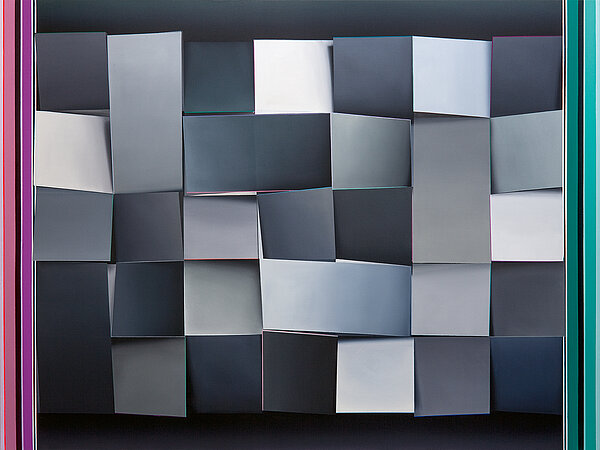Enrico Bach creates his works with a great deal of reflection. He is well versed in art history and chooses themes for his canvases that have occupied painting for many centuries: the depiction of space in perspective, the modulation of light and shade, and the material quality of the subject.
Bach’s ambition to create the perfect illusion recalls the competition between Zeuxis and Parrhasios, two painters of antiquity. The difference is that in Tetra II we see neither faithfully depicted fruit nor a deceptively realistic painted drape, but geometrical shapes that look as though one could reach out and touch them, and that have been pieced together in a tectonic composition. In this large work, a tracery of forms set between two coloured stripes on either side opens up to create the impression that the artist has transposed the grid structures of concrete art into the third dimension. It is as if one were looking at an orthogonal weave in various shades of grey, which – although two-dimensional by nature – looms out like a relief into space.
Bach takes inspiration for his paintings from visual structures he encounters in everyday life; in the case of Tetra II the stacks of speaker cabinets he saw at an electronic music festival. But at the same time his inquiry into abstract spatial structures has undergone a rigorous development. On the one hand he turned from representational painting to a constructive, geometrical vocabulary; on the other, setting out from collage he arrived at a form of painting that gives the semblance of three-dimensionality.
The fascinating trompe-l’œil effect in the painting Tetra II derives from the interplay of an illusionist sense of plasticity, carefully staged lighting, and a materiality whose cool metallic smoothness seems literally tangible. But on closer inspection the artifice becomes apparent: the traces of the act of painting are revealed, and the use of light and shade evinces flaws in the perspective. Here Bach pulls out every stop in his brush technique – placing himself on the one hand in the continuum of the painting tradition, while at the same time undermining our habitual ways of seeing. (Susann Scholl)
Enrico Bach
1980 born in Leipzig
Lives and works in Karlsruhe


